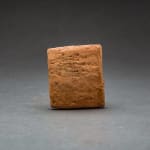Sumerian Cuneiform Tablet, 2029 BCE
1.65 x 1.93
AM.0061
Further images
Sumerian cuneiform is one of the earliest known forms of written expression. First appearing in the 4th millennium BC in what is now Iraq, it was dubbed cuneiform (‘wedge-shaped’) because...
Sumerian cuneiform is one of the earliest known forms of written expression. First appearing in the 4th millennium BC in what is now Iraq, it was dubbed cuneiform (‘wedge-shaped’) because of the distinctive wedge form of the letters, created by pressing a reed stylus into wet clay. Early Sumerian writings were essentially pictograms, which became simplified in the early and mid 3rd millennium BC to a series of strokes, along with a commensurate reduction in the number of discrete signs used (from c.1500 to 600). The script system had a very long life and was used by the Sumerians as well as numerous later groups – notably the Assyrians, Elamites, Akkadians and Hittites – for around three thousand years. Certain signs and phonetic standards live on in modern languages of the Middle and Far East, but the writing system is essentially extinct. It was therefore cause for great excitement when the ‘code’ of ancient cuneiform was cracked by a group of English, French and German Assyriologists and philologists in the mid 19th century AD. This opened up a vital source of information about these ancient groups that could not have been obtained in any other way.
Cuneiform was used on monuments dedicated to heroic – and usually royal – individuals, but perhaps its most important function was that of record keeping. The palace-based society at Ur and other large urban centres was accompanied by a remarkably complex and multifaceted bureaucracy, which was run by professional administrators and a priestly class, all of whom were answerable to central court control. Most of what we know about the way the culture was run and administered comes from cuneiform tablets, which record the everyday running of the temple and palace complexes in minute detail, as in the present case. The Barakat Gallery has secured the services of Professor Lambert (University of Birmingham), a renowned expert in the decipherment and translation of cuneiform, to examine and process the information on these tablets. His scanned analysis is presented here. Despite the corroded surface it is possible to decipher part of this tablet. It records the payment in kind to a gardener.
Professor Lambert’s translation is provided below:
Clay tablet, 49x42 mm., with 10 lines of Sumerian cuneiform on obverse and reverse. The surface is mostly corroded, but it is possible to read the bottom of the obverse and the whole of the reverse:
Translation
. . . Shapum, the gardener, receive
Month: barley harve
Year: Shu-Sin built the temple of Shara in Umm
This is thus the record of payment in kind to a gardener. He would have been working mostly or entirely on date palm culture, since that was the only real tree in Sumer, and one that provided food and some other byproducts.
The date is the 9th year of Shu-Sin, fourth king of the Third Dynasty of Ur, c. 2029 B.C.
Cuneiform was used on monuments dedicated to heroic – and usually royal – individuals, but perhaps its most important function was that of record keeping. The palace-based society at Ur and other large urban centres was accompanied by a remarkably complex and multifaceted bureaucracy, which was run by professional administrators and a priestly class, all of whom were answerable to central court control. Most of what we know about the way the culture was run and administered comes from cuneiform tablets, which record the everyday running of the temple and palace complexes in minute detail, as in the present case. The Barakat Gallery has secured the services of Professor Lambert (University of Birmingham), a renowned expert in the decipherment and translation of cuneiform, to examine and process the information on these tablets. His scanned analysis is presented here. Despite the corroded surface it is possible to decipher part of this tablet. It records the payment in kind to a gardener.
Professor Lambert’s translation is provided below:
Clay tablet, 49x42 mm., with 10 lines of Sumerian cuneiform on obverse and reverse. The surface is mostly corroded, but it is possible to read the bottom of the obverse and the whole of the reverse:
Translation
. . . Shapum, the gardener, receive
Month: barley harve
Year: Shu-Sin built the temple of Shara in Umm
This is thus the record of payment in kind to a gardener. He would have been working mostly or entirely on date palm culture, since that was the only real tree in Sumer, and one that provided food and some other byproducts.
The date is the 9th year of Shu-Sin, fourth king of the Third Dynasty of Ur, c. 2029 B.C.





